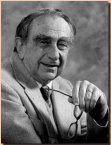 Edward (Ede) Teller - (b. Jan. 15, 1908, Budapest) Edward (Ede) Teller - (b. Jan. 15, 1908, Budapest)
Physicist, instrumental in the Manhattan Project, Father of the the H-Bomb: co-developed the Atomic Bomb and Discovered BET equation. Edward Teller is most widely known for his significant contributions to the first demonstration of thermonuclear energy; in addition he has added to the knowledge of quantum theory, molecular physics, and astrophysics. Young Edward was a mathematical prodigy. In 1926, Edward left Budapest to study chemical engineering in Karlsruhe, Germany. In Karlsruhe, Teller became intrigued by physics, particularly the new theory of quantum mechanics. After recovering from teh loss of his foot in a streetcar accident, he learned to walk with a prosthesis, and transferred to the University of Leipzig, to study with Werner Heisenberg, who was in the forefront of the new physics. Teller received his doctorate in physics in 1930 and took a job as research consultant at the University of Gottingen. His first published paper: "Hydrogen Molecular Ion," was one of the earliest statements of what is still the most widely held view of the molecule. Edward Teller made a major contribution to the development of the atomic bomb. Teller's friend Leo Szilárd enlisted Albert Einstein to bring this danger to the attention of President Franklin Roosevelt. Roosevelt appealed to the scientific community to mobilize for the defense of freedom. In 1941 Teller joined America's best physicists in the top secret Manhattan Project. Their mission: to develop the atom bomb before the Germans did. From the beginning, some scientists had feared that an uncontrolled nuclear reaction, like that of the proposed bomb, might continue indefinitely, consuming the earth. Teller's calculations reassured the team that the nuclear explosion, while enormously powerful, would only destroy a limited area.  Seen here with President Kennedy accepting the National Medal of Science, Edward Teller managed Los Alamos research on the "Super," as he called the hydrogen bomb. Destruction of Hiroshima and Nagasaki in Japan and the end of World War II slowed "Super" research. Teller, a strong anti-Communist and sensitive to U.S. and Soviet relations, pushed unsuccessfully to accelerate work on a super-bomb. He was frustrated by the post-war direction of Los Alamos. He accepted a University of Chicago professorship and left Los Alamos in October 1945. In April 1946, Teller returned to Los Alamos and led a secret conference on the "Super." The conference reviewed his earlier work on fusion, which led to his full-time return to Los Alamos in 1949 to continue research on the hydrogen bomb. On January 31, 1950, President Truman approved hydrogen bomb development and testing, partly as a result of the first Soviet atomic test the previous August. Since 1975, Edward Teller has been senior research fellow at the Hoover Institute for the Study of War, Revolution and Peace at Stanford University. He is also Director Emeritus at the Lawrence Livermore National Laboratory. Seen here with President Kennedy accepting the National Medal of Science, Edward Teller managed Los Alamos research on the "Super," as he called the hydrogen bomb. Destruction of Hiroshima and Nagasaki in Japan and the end of World War II slowed "Super" research. Teller, a strong anti-Communist and sensitive to U.S. and Soviet relations, pushed unsuccessfully to accelerate work on a super-bomb. He was frustrated by the post-war direction of Los Alamos. He accepted a University of Chicago professorship and left Los Alamos in October 1945. In April 1946, Teller returned to Los Alamos and led a secret conference on the "Super." The conference reviewed his earlier work on fusion, which led to his full-time return to Los Alamos in 1949 to continue research on the hydrogen bomb. On January 31, 1950, President Truman approved hydrogen bomb development and testing, partly as a result of the first Soviet atomic test the previous August. Since 1975, Edward Teller has been senior research fellow at the Hoover Institute for the Study of War, Revolution and Peace at Stanford University. He is also Director Emeritus at the Lawrence Livermore National Laboratory.
Trivia: - There is indeed an asteroid named Teller orbiting around the Sun, discovered by E.F. Helin in 1989.)
- Purchase his book, "Memoirs" at Amazon
- See The Hall of Science and Exploration at the American Academy of Achievement. The in-depth site has an interview, more background, and even videos.
- Or read another Interview with Teller
- See a fascinating history in pictures at this anti-Teller site
- See The Spirit of Hungary or Purchase this incredible book!
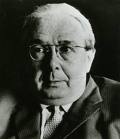 Leo Szilárd - (b. Feb 11, 1898, Budapest, d. May 30, 1964, La Jolla, California) Leo Szilárd - (b. Feb 11, 1898, Budapest, d. May 30, 1964, La Jolla, California)
Physicist - Co-developed the Atomic Bomb, patented the nuclear reactor, catalyst of the Manhattan Project: Conceived the nuclear chain reaction and campaigned for nuclear disarmament, though the first to consider the application of the atom to making bombs. Achieved first sustained nuclear fission reaction with Enrico Fermi. Identified the unit or "bit" of information. Szilard first realized the potential use of nuclear fission in an atomic bomb, and worked with Fermi on the first nuclear reaction. Seen here with Albert Einstein, his other ideas included the electron microscope, cyclotron, and linear accelerator. As an inventor, he even has numerous joint patents with Einstein. He proposed term "breeder" to describe an nuclear reactor and holds a joint 1955 US patent on the nuclear reactor with Enrico Fermi. In 1960, after a personal meeting with Soviet Premier Nikita Khrushchev, during Khrushchev's visit to New York, he proposed methods of reducing US-USSR tensions, including the Washington-Moscow "hotline." Shared Atoms for Peace Award with Eugene Wigner and devoted much of his life toward nuclear disarmament and preventing the harmful use of nuclear energy. With Wigner, he convinced Einstein, the scientific community, and the President to start the Manhattan Project. Albert Einstein's 1939 letter to President Franklin Roosevelt urging development of an atomic bomb - the famous document that started the Nuclear Age - was not written by Einstein at all. It was ghostwritten for him by Szilard. In 1939, Szilard and Princeton scientist Eugene Wigner approached Einstein to ask a vital favor: Given his great stature, would he lend his name to the promotion of a serious study of nuclear energy's wartime applications and the design and construction of an atomic bomb? Einstein agreed, although he confessed relative ignorance about nuclear chain reactions. Szilárd wrote a draft and presented it to him for his signature on Aug. 2. It spoke of the "vast amounts of power and large quantities of new radium-like elements [that] would be generated" by a nuclear chain reaction set off in a large chunk of uranium. The message finally went to Roosevelt. Later Einstein did write and sign two follow-up messages which, together with the first, led to the 1942 formation of the Manhattan Project, - which developed the bombs dropped on Japan in 1945. Szilárd was one of the project's guiding forces; Einstein had nothing whatsoever to do with it and wrote: "I ... only acted as a mailbox," Einstein later wrote. "They [Szilard and Wigner] brought me a finished letter, and I simply mailed it." Trivia: - Visit Leo Szilárd Online. A really incredible site! By author and Szilárd biographer, Gene Dannen. With Bio, classified documents regarding the Manhattan Project & the bomb, the actual letters to the Presidents: the Szilárd Petition to Truman and letter from Einstein to Roosevelt.
- See The Spirit of Hungary or Purchase this incredible book!
 John von Neumann - (b. János Lajos Margittai Neumann on Dec 28, 1903, Budapest - d. Feb 8, 1957, Washington, DC) John von Neumann - (b. János Lajos Margittai Neumann on Dec 28, 1903, Budapest - d. Feb 8, 1957, Washington, DC)
Legendary Mathematician, Physicist, Logician, and Computing Pioneer. Father of Binary Code and the Stored Program Computer, the keys to modern computer computer programming. Father of Game Theory. Proposed Implosion and co-developed the Atomic Bomb. Built a solid framework for quantum mechanics. Played a key role in the development of the U.S. ballistic missile program. Education
Neumann was a child genius. When only six years old he could divide eight-digit numbers in his head. He learned calculus by eight and, amused everyone by memorizing phone book pages, and in 1911, entered the Lutheran Gymnasium (Senior Secondary School) where is recognized genius soon affords him special tuition. Incredibly at the same school, in the class just ahead Neumann's, was another genius, Eugene Wigner (below). In 1921, he enters the University of Budapest to study mathematics in 1921. But he did not attend lectures. Instead he simultaneously attended the University of Berlin that same year to study chemistry. Despite not attending his lectures, he still achieved outstanding results in Budapest. He received both his diploma in chemical engineering from the Technische Hochschule in Zürich and his doctorate in mathematics from the University of Budapest in 1926. In 1930 von Neumann became a visiting lecturer at Princeton University, being appointed professor there in 1931. He along with Einstein became one of the original six mathematics professors in 1933 at the newly founded Institute for Advanced Study (I.A.S.) in Princeton, a position he kept for the remainder of his life. The ENIAC, Modern Computing, and Dr. Strangelove
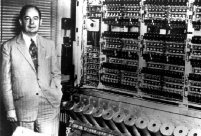 Von Neumann was the center of the group who created the "stored program" concept that made truly powerful computers possible. A chance meeting brought him to work on the ENIAC (seen on the right). ENIAC had a big problem. It had no memory. As a consultant to Eckert and Mauchly on the ENIAC, he devised a concept for computer architecture that remains with us to this day. He conceived a fundamental idea that serves all modern computers - that a computer's program and the data that it processes does not have to be fed into the computer while it is working but can be kept in the computer's memory - a notion generally referred to as the stored-program computer. Known subsequently as the "von Neumann architecture", the stored-program computer (where both the instructions and the data they operate upon reside together in memory) with its central controller, I/O, and memory was outlined in a "Draft Report" and paved the way for the modern era of computing. When he died, the Secretaries of Defense, the Army, Air Force, and Navy and the Joint Chiefs of staff were all gathered around his bed, attentive to his last gasps of technical and policy advice. Von Neumann was the center of the group who created the "stored program" concept that made truly powerful computers possible. A chance meeting brought him to work on the ENIAC (seen on the right). ENIAC had a big problem. It had no memory. As a consultant to Eckert and Mauchly on the ENIAC, he devised a concept for computer architecture that remains with us to this day. He conceived a fundamental idea that serves all modern computers - that a computer's program and the data that it processes does not have to be fed into the computer while it is working but can be kept in the computer's memory - a notion generally referred to as the stored-program computer. Known subsequently as the "von Neumann architecture", the stored-program computer (where both the instructions and the data they operate upon reside together in memory) with its central controller, I/O, and memory was outlined in a "Draft Report" and paved the way for the modern era of computing. When he died, the Secretaries of Defense, the Army, Air Force, and Navy and the Joint Chiefs of staff were all gathered around his bed, attentive to his last gasps of technical and policy advice. Though he is widely known for his work with the Manhattan Project, Time Magazine writes: "virtually all computers today, from $10 million supercomputers to the tiny chips that power cell phones and Furbies, have one thing in common: they are all "Von Neumann machines," variations on the basic computer architecture that John von Neumann, building on the work of Alan Turing, laid out in the 1940s. Men have become famous for less. But in the lifetime of this Hungarian-born mathematician who had his hand in everything from quantum physics to U.S. policy during the cold war, the Von Neumann machine was almost the least of his accomplishments...As rivalry with the Soviet Union heated up, Von Neumann became a strategic adviser on defense policy. He was appointed by President Dwight D. Eisenhower to the Atomic Energy Commission, which oversaw the postwar buildup of the U.S. nuclear arsenal. Von Neumann's game theory became a tool to analyze the unthinkable--global nuclear war--and led to the doctrine of "mutually assured destruction," which would shape U.S. strategy for the next two decades. Von Neumann also became an icon of the cold war. Disabled with pancreatic cancer, he stoically continued to attend AEC meetings until his death in 1957. The wheelchair-bound scientist with the Hungarian accent who mathematically analyzed doomsday is said to have been a model for Stanley Kubrick's Dr. Strangelove." The Manhattan Project and US Government
During and after World War II, von Neumann served as a consultant to the armed forces. His valuable contributions on the Manhattan Project included a proposal of the implosion method for bringing nuclear fuel to explosion, his participation in the development of the hydrogen bomb and his use of his extensive knowledge of hydrodynamics to attempt to create an isotope of uranium with great potential for energy. Howard Feingold writes, "Von Neumann was a very important, probably indispensable, member of the Manhattan Project scientific team. Oppenheimer, Fermi, Teller, Bohr, Lawrence, and the other members of the most gifted scientific gathering of minds in history were as awed by Johnny's intellect as anyone else who ever met him. More impressively, they were as reliant on his mathematical judgment as anyone else. In that galactic cluster of world-class physicists, chemists, mathematicians, and engineers, it was a rare tribute that von Neumann was put in charge of the mathematical calculations upon which all their theories--and the functioning of their "gadget"--would depend." From 1940 he was a member of the Scientific Advisory Committee at the Ballistic Research Laboratories at the Aberdeen Proving Ground in Maryland. He was a member of the Navy Bureau of Ordnance from 1941 to 1955, and a consultant to the Los Alamos Scientific Laboratory from 1943 to 1955. From 1950 to 1955 he was a member of the Armed Forces Special Weapons Project in Washington, D.C. Von Neumann ended up a key policy-maker in the fields of nuclear power, nuclear weapons, and intercontinental ballistic weaponry. In 1953 he became chairman of the Air Force Strategic Missiles Evaluation Committee. He was appointed Director of the Atomic Energy Commission and Chaired the Atlas (later ICBM) Scientific Advisory Committee which monitored Atlas progress and sought to speed up development of Intercontinental Ballistic Missiles. As chairman of both committees, Dr. von Neumann proposed the practicality of using ballistic missiles to deliver nuclear weapons. He believed the Soviets had an edge in the development of an intercontinental ballistic missile and predicted a significant missile gap between the United States and the Soviet Union by the late 1950s. Without greater funding, research and development of an operational Atlas ICBM was scheduled for earliest completion in 1963. Based on recommendations by the von Neumann committees and persuasion by Trevor Gardner (the Air Force Assistant Secretary for Research and Development), the United States pressed forward with its missile program at a faster rate and successfully launched an Atlas missile in December 1958. Awards
In 1955 President Eisenhower appointed him to the Atomic Energy Commission, and in 1956 he received its Enrico Fermi Award, knowing that he was incurably ill with cancer. Von Neumann received two Presidential Awards, the Medal for Merit in 1947 and the Medal for Freedom in 1956. Also in 1956 he received the Albert Einstein Commemorative Award. Trivia: - There is a Crater Von Neumann on the Moon, just east of the Szilard Crater!
- Read Time Magazine's Article, "John von Neumann: Computing Cold Warrior."
- See US News's John von Neumann: A Calculating Man.
- See Howard Rheingold's Brainstorm on the development the computer. My more technically saavy readers should see the "Von Neumann Architecture."
- Here is a US Air Force article on his role in the development of Ballistic Missiles: http://www.spacecom.af.mil/hqafspc/history/von_neumann.htm
- Here are some historical resources: http://ei.cs.vt.edu/~history/VonNeumann.html. Or read these at the University of St. Andrews in Scotland: Von Neumann Bio or Mathematicians Born in Hungary . Another good site is Who's Who in Computing.
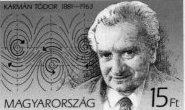 Tódor (Theodore) von Kármán - (b.1881 Budapest - d.1963 Aachen, Germany) Tódor (Theodore) von Kármán - (b.1881 Budapest - d.1963 Aachen, Germany)
Aeronautical Engineer & Mathematician. The Father of the Supersonic Flight, first recipient of National Medal of Science from J.F.K., and a founder of the aeronautical and astronautical sciences. Developed first helicopter tethered to the ground that was able to maintain hovering flight. He was one of the creators of scientific fluid mechanics. Designed the first rocket to reach interstellar space! Education and Early Developments
Theodore Von Kármán was a mathematical prodigy. He became a student of the present Trefort Street Grammar School in Budapest, where he would win competitions of Mathematics. His father, worried that his son would become a mathematical "freak," pushed him toward engineering. In 1902, he received his degree in mechanical engineering from the Royal Hungarian Technical University. Following initial success - on his father's advice - he went to Göttingen in 1906, on a scholarship of the Hungarian Academy of Sciences where he received his PhD and taught. Kármán writes, "It was in Göttingen that I performed the experiments and I got my doctoral degree in 1908. My curiosity was directed towards solid bodies and flexibility. First I got engaged in aerodynamics. I think I first heard about supersonic jet propulsion from Albert Fonó." He was nominated head of the department of aeronautics at the university of Aachen. It was there that he met professor H. Junkers, former head of the department of internal combustion engines. He involved Kármán in his airplane-designing work, and they developed together the wings of legendary and ever sturdy Junkers J-1. WWI
In World War I he was called into military service, and in August 1915, when the chiefs of staff of the Austro-Hungarian army realized that Kármán had a good knowledge of aviation as well, an experimental laboratory was put to his disposal in the empty Zeppelin hangar where he built a wind tunnel adequate for the testing of propellers. He played a substantial role in the preparation of PKZ (Petróczy-Kármán-Zurovecz) helicopters. It was at the Military Aircraft Factory at Fischamend in Austria, where he led the development of the first helicopter tethered to the ground that was able to maintain hovering flight. After the war in 1918, he came to Budapest and got to the Ministry of Public Education where he spared no effort in order to modernize university education. Among several of his important measures it should be mentioned that he doubled the number of Mathematics classes. In 1919 he returns to Aachen where he became director of the Institute of Aerodynamics. He lectured on gliding aircrafts. One of his students was Messerschmidt, the later famous airplane constructor. The New World, WWII, and Supersonic Flight
Politics put an end to the years in Aachen. He left Germany. The new world - the United States - became the scene of his creative period. In 1930, he became director of the Guggenheim Aeronautics Laboratory at the California Institute of Technology. His laboratory at the California Institute of Technology later became the National Aeronautics and Space Administration (NASA) Jet Propulsion Laboratory. In 1933, he founded the U.S. Institute of Aeronautical Sciences. In 1939, he was commissioned to design a wind tunnel for the purposes of supersonic aviation. He built the first wind tunnel reaching sonic speed by the order of the Boeing Works. He had a leading role in the development of the B-36, B-47 and B-52 bombers, as well as the Atlas, Titan and Minuteman rockets. Kármán made unique contributions to the theory of elasticity, produced important findings on the strength of materials, aircraft structures, aerodynamics and thermodynamics. For his pioneering role in aviation science, Kármán is often remembered as "the father of supersonic flight." In 1942, he established the Aero-Jet Engineering Corporation. When in November 1943, German V-2s began to bombard London, this corporation was commissioned to develop long-range rockets. The first rocket, launched in December, 1944, reached the height of 11 miles (17.5 km). In 1945, the height was over 71 km; and in 1949, their rocket got as high as 393 km. This was the first rocket to have reached interstellar space. In 1944, he was appointed Chairman of the Advisory Board of the US Army Air Force and in 1952 was Chairman of NATO Advisory Group for Aeronautical Research & Development. His mathematical breakthroughs made supersonic and space flight possible. A stamp was issued in his honor by the US in 1992. He is a Fellow of The Royal Society and memorialized by Crater Karman on the Moon and Mars! Quote: "The scientist describes what is; the engineer creates what never was."
Quoted in A L Mackay, Dictionary of Scientific Quotations (London 1994) Trivia: - there is a mount named Von Kármán Crater on Mars
- a huge ring in the southern part of the far side of the Moon has also been named Von Kármán Crater
- See Encylopedia Britannica's article: http://britannica.com/bcom/eb/article/7/0,5716,45787+1,00.html
- Or read more about him and other great scientists at The Technical University of Budapest.
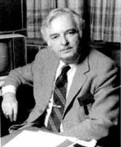 John Kemény - (b. 5/31/1926, Budpapest - d. 12/26/1992, Hanover, New Hampshire) John Kemény - (b. 5/31/1926, Budpapest - d. 12/26/1992, Hanover, New Hampshire)
Mathematician, President of Dartmouth, Leader and innovator in mathematics education, and "Father of Microcomputing": Developed BASIC computer language. Manhattan Project Mathematician at 17! "Einstein was not very good at math" "The most dangerous voice you will ever hear is the evil voice of prejudice that divides black from white, man from woman, Jew from gentile. Listen to the voice that says man can live in harmony. Use your very considerable talents to make the world better." Dr. Kemény developed Beginner's All-Purpose Symbolic Instruction Code (BASIC) in 1964, along with Thomas Kurtz, because the pair wanted a simple computer language. BASIC is often considered the beginner's bible in computing, and is included with almost every microcomputer. However, the language has numerous variations because the two men didn't copyright it. In the 1980s, they developed True BASIC, a more powerful version of BASIC that met ANSI and ISO standards. Contributor Steve Colman writes: "John Kemeny's claim to fame was that he was a class mate of mine at the Berzsenyi Daniel High School, then on Marko utca. At age 13, when I was already well established as the class dunce, he was discovered to be a genius. In August 1939 he left for USA, where at age 17 he was called up as a soldier and sent to be a mathematician on the Manhattan Project (Atom bomb). [Following the war, he returned to Princeton and in 1947 received his B.A. summa cum laude, Phi Beta Kappa.] [While working on is PhD., ] he became an assistant to Albert Einstein [at the Institute for Advanced Study.] ...He became the "Father of Microcomputing" due to his (and Tom Kurtz's) writing the code of BASIC. He was a well known mathematician, wrote several books and became President of Dartmouth [in 1970 on one condition: that he be allowed to continue teaching Philosophy and Mathematics.] A heart attack killed him in 1992. Kemény's brother-in-law was George Mikes, a fellow Hungarian who is very well known as the author of "How to be an Alien" and other bestsellers. He should also be on your list." Now he is [hipcat] Many awards and honors were bestowed on Kemeny. He was given the New York Academy of Sciences Award in 1984, the Institute of Electrical Engineers Computer Medal in 1986 and the Louis Robinson Award on 1990. He received twenty honorary degrees. Trivia: - In 1979, President Jimmy Carter asked him to chair the commission investigating the Three Mile Island nuclear accident: "The Kemeny Commission," as it came to be called, was very critical of the nuclear power industry and its federal regulators.
- Kemeny was Albert Einstein's research assistant. Kemeny later wrote:
"People would ask - did you know enough physics to help Einstein? My standard line was: Einstein did not need help in physics. But contrary to popular belief, Einstein did need help in mathematics. By which I do not mean that he wasn't good at mathematics. He was very good at it, but he was not an up-to-date research level mathematician. His assistants were mathematicians for two reasons. First of all, in just ordinary calculations, anybody makes mistakes. There were many long calculations, deriving one formula from another to solve a differential equation. They go on forever. Any number of times we got the wrong answer. Sometimes one of us got the wrong answer, sometimes the other. The calculations were long enough that if you got the same answer at the end, you were confident. So he needed an assistant for that, and, frankly, I was more up-to-date in mathematics than he was."
- In 1971, he used computer terminals in his office and at home. He predicted that by 1990 such capability would be as common as telephones and said it would raise the intellectual level of the average home to "the pre-television level."
- Columbia University has a great bio entitled, "John G. Kemeny: BASIC and DTSS: Everyone a Programmer"
- The History of Mathematics Archive at University of St. Andrews in the UK and BCC.
- Read True Basic: A sketch of John Kemeny for the Dartmouth Alumni Magazine
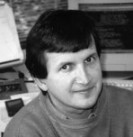 Charles Simonyi (b. 9/10/1948, Budapest) Charles Simonyi (b. 9/10/1948, Budapest)
Billionaire Computer Scientist and Chief Architect, Microsoft Corporation
Father of WYSIWYG and Hungarian Notation During the 1970s at Xerox PARC, Charles Simonyi led a team of programmers in the development of Bravo, the first WYSIWYG (What You See Is What You Get, pronounced wizzywig, i.e. MS Word) word processing editor. Bravo was a fundamental departure from the way information was previously displayed and organized and it was part of PARC's contribution that changed the face of computing and ultimately led to personal computing. Simonyi, born in Budapest, Hungary, holds a bachelor of science degree in engineering mathematics from the University of California at Berkeley and a doctorate in computer science from Stanford University. He worked for the Xerox Palo Alto Research Center from 1972-80 and joined Microsoft in 1981 to start the development of microcomputer application programs. He hired and managed teams who developed Microsoft Multiplan, Word, Excel, and other applications. In 1991, he moved to Microsoft Research where he has been focusing on Intentional Programming. He is generally thought of as one of the most talented programmers at Microsoft. Dr. Simonyi, whose long career has made him independently wealthy, has endowed two chairs: the Charles Simonyi Professorship For The Understanding Of Science at Oxford University which is held by the evolutionary biologist Richard Dawkins; and the Charles Simonyi Professorship in Theoretical Physics at the Institute for Advanced Study. Trivia: Dating Martha Stewart Resources:
Interview with Simonyi,
The Edge.org,
Intentional Programming
 Farkas (Wolfgang) Kempelen de Pázmánd - (b.1734 Pozsony then capital of Hungary [called Bratislava after Czech and Slovak annexation], d. Vienna in 1804) Farkas (Wolfgang) Kempelen de Pázmánd - (b.1734 Pozsony then capital of Hungary [called Bratislava after Czech and Slovak annexation], d. Vienna in 1804)
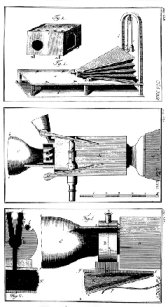 Inventor - First Speaking Machine - first experimental phonetician Inventor - First Speaking Machine - first experimental phonetician
His main concern was the study of human speech production, with therapeutic applications in mind. He has been called the first experimental phonetician. He was first to observe minute movements in formation of spoken sounds and in 1788 constructed first "speaking machine." In his book Mechanismus der menschlichen Sprache nebst Beschreibung einer sprechenden Maschine (1791) he included a detailed description of his speaking machine - in order for others to reconstruct it and make it more perfect. The drawings shown here to the right are taken from this book. Von Kempelen's machine was the first that allowed to produce not only some speech sounds, but also whole words and short sentences. It used a bellows to supply air to a reed which, in turn, excited a single, hand-varied resonator for producing voiced sounds. Consonants, including nasals, were simulated by four separate constricted passages, controlled by the fingers of the other hand. An improved version of the machine was built from von Kempelen's description by Sir Charles Wheatstone (of the Wheatstone Bridge, and who is credited in Britain with the invention of the telegraph). This early phonograph is on display at Deutsches Museum in Munich. The genial Kempelen worked in almost every branch of technical science. He organized the textile industry in the South of Hungary, and built the Pozsony bridge of pontoons in the North, Kempelen was the first to experiment with the use of printed letters for teaching the blind in Paris. Kempelen amazed the world with his "chess-playing machine," with which he traveled throughout Europe, astonishing even Napoleon. The Emperor is said to have lost his game with the machine, upon which he swept the figures off the board in frustration. The secret of this machine was never revealed. - For more see, "Wolfgang von Kempelen's and the subsequent speaking machines."
- Here is yet another in-depth look at this remarkable man and his invention: http://www.slovakradio.sk/kultura/expstudio/kempe.html
- See The Spirit of Hungary or Purchase this incredible book!
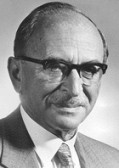 Dennis Gábor (b. 1900, Budapest - d. 1979, London) Dennis Gábor (b. 1900, Budapest - d. 1979, London)
Nobel Prize in 1971 for his investigation and development of holography. (adapted from his autobiography)
Dr. Dennis Gabor was born in Budapest, Hungary, on June 5, 1900, the oldest son of Bertalan Gabor, director of a mining company, and his wife Adrienne. His life-long love of physics started suddenly at the age of 15. Fascinated by Abbe's theory of the microscope and by Gabriel Lippmann's method of colour photography, he, with his late brother George built up a home laboratory and began experimenting with wireless X-rays and radioactivity. He entered the Technische Hochschule Berlin and acquired a Diploma in 1924 and his Doctorate of Engineering in 1927 in electrical engineering. While there he spent his free time working on physics at the University of Berlin. His doctorate work was the development of one of the first high speed cathode ray oscillographs and in the course of this, made the first iron-shrouded magnetic electron lens. In 1927 he joined Siemens & Halske AG and made one of his first successful inventions; the high pressure quartz mercury lamp with superheated vapour and the molybdenum tape seal, since used in millions of street lamps. In what Dennis calls his "first lesson in serendipity," he invented the mercury lamp while attempting to develop a cadmium lamp which proved unsuccessful.
With the rise of Hitler In 1933, Dennis left Germany and after a short period in Hungary went to depression stricken England. Finding a jobs as a foreigner was very difficult. He eventually obtained employment with the British firm, Thomson-Houston Co., in Rugby, on an inventor's agreement. His work on gas discharge tubes gave him a foothold in the BTH Research Laboratory where he remained until the end of 1948. Dennis writes that the years after the war were the most fruitful. One his first papers was on communication theory. He also developed a system of stereoscopic cinematography, and in the last year at BTH carried out the basic experiments in holography, at that time called "wavefront reconstruction."
On January 1, 1949 he joined the Imperial College of Science & Technology in London, first as a Reader in Electronics, and later as Professor of Applied Electron Physics, until his retirement in 1967. With post-graduate assistants, he attacked many problems, almost always difficult ones. Developments included: a holographic microscope; a new electron-velocity spectroscope; an analogue computer which was a universal, non-linear "learning" predictor, recognizer and simulator of time series; a flat, thin colour television tube; and a new type of thermionic converter. Theoretical work included communication theory, plasma theory, magnetron theory, and a scheme of fusion.
After his retirement in 1967 he remained connected with the Imperial College as a Senior Research Fellow and became Staff Scientist of CBS Laboratories, Stamford, Conn. where he collaborated with the President, life-long friend, and father of the color television, Dr. Peter C. Goldmark, in many new schemes of communication and display. - See my Dennis Gabor Site for more
 Tivadar Puskás - (b.
9/17/1844, Pest - d. 1893) Tivadar Puskás - (b.
9/17/1844, Pest - d. 1893)
Inventor, Telephone Pioneer / Thomas Edison's Colleague - Devised the idea of using telephone exchanges between subscribers, invented the switchboard and built Europe's first telephone exchange. Inventor of the Telephonograph (forerunner to radio) and Telephone News In 1874, after a successful Travel Agency enterprise in Vienna, he travels to America by ship. Buys some land in the gold-fields of Colorado and starts searching for gold. In New York he gets acquainted with Edison and Edison's invention, the carbon microphone. There it occurred to him to set up a central exchange which would be suitable for connecting several persons talking. In 1876 he travels to London and Brussels where he is involved in discussions about the latest telegraphs and the development of a telegraphic network for cities. At the news of Edison's invention, he returns to America where he becomes Edison's collaborator and is engaged in working out the details of the telephone exchange. In 1877 he goes to London on behalf of Edison to register the patent for the phonograph. In 1878 he moves from London to Paris. On the continent, as Edison's representative, he has dealt with every patent. In addition, Puskás worked on the electric lighting of London (1882) and the telephone network in Madrid (1883). Apart from this he sets up his own enterprise: an agency for selling patents. The main reason for him moving to Paris is to build a telephone exchange, the first in all of the capitals of Europe, where in 1879, he built Europe's first telephone exchange. In Budapest, the world's fourth exchange commenced operating in 1881. It was in this city that another of Puskás's inventions, "the speaking newspaper" (Telefonhírmondó), was first put into practice on February 15, 1893, sending news and music to subscribers as a forerunner of modern telecommunications. Puskas was a genius of online content: His service featured up-to-the-minute stock reports and sports results, live music, a newsroom delivering late-breaking news, and programming for children. Pundits of the time, as Thomas White's online archives reveal, sounded a lot like pundits today. "Will the newspaper always remain in a form now so familiar," pondered a reporter for the Living Age in 1903, "and will the news always be printed from type upon paper?" A similar venture had already installed theatrophones in fashionable Paris hotels and cafes. Subscriber lines also were strung across London; Queen Victoria had one in her sitting room. Trivia - Coined the term "Hello" an Englishized version of "Hallom" which means "I hear you" - his famous words to Edison on the successful test of his new invention, the telephone.
- October 1879, Tivadar Puskás became a member of the board of directors in the Edison Company
- Read TIVADAR PUSKÁS: From Pest to Nagyvárad - via London
- Go here for more on his life as well as academic achievements and inventions.
- See Hungarians in the History of Communication
- Read all about his invention, Telefon-Hirmondo, or Newsteller
- See the fascinating Little Stories about Great Hungarians
- See The Spirit of Hungary or Purchase this incredible book!
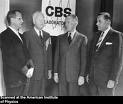 Peter Carl Goldmark - (b. 12/2/1906, Budapest - d. Westchester County, NY, 12/7/1977) Peter Carl Goldmark - (b. 12/2/1906, Budapest - d. Westchester County, NY, 12/7/1977)
Engineer, CBS Chief Scientist - Invented the Color Television, 33 1/3 LP Record, and the Electronic Video Recorder! National Medal of Science "Peter had more ideas in a day than most others in a lifetime" - CBS President, Frank Stanton
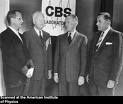 Dr. Goldmark, responsible for over 160 inventions in his storied career, studied at the University of Vienna (B.S., 1929, Ph.D., 1931) and from 1931-33 worked for a radio company in England. After emigrating to the United States in 1933, he worked as a construction engineer until joining the Columbia Broadcasting System (CBS) in 1936. There he developed the first commercial color television system, which used a rotating three-color disk, and announced in 1940 that CBS had a marketable color television and broadcasted in New York. Although initially approved by the Federal Communications Commission, RCA, which had invested heavily in black-and-white technology, used its lobbying clout to keep the FCC from adopting the CBS system. Goldmark also developed the 33 1/3 LP phonograph record that greatly increased the playing time of records. The LP Phonograph record may not not seem exciting in this, the age of the compact disc, but when Peter Goldmark perfected it in 1948, music lovers rejoiced. Even more crucial, perhaps, was that Goldmark's record was made of vinyl, rather than the shellac-and-clay blend previously employed. Plastics discs were not only tougher and less noisy, but also allowed for narrower grooves and therefore more music -- up to half an hour per side. Finally, audiophiles could settle in for a nice long listen. Later, Goldmark would achieve fame for the first electronic video recording system-the forerunner for the VCR in your home today. He became the chief engineer and President of CBS's Laboratory in 1954. He also developed a scanning system used by the Lunar Orbiter spacecraft in 1966 to transmit photographs to the earth from the moon. CBS received credit for all of his work. As a result, Goldmark has not been given the recognition he deserves. Dr. Goldmark, responsible for over 160 inventions in his storied career, studied at the University of Vienna (B.S., 1929, Ph.D., 1931) and from 1931-33 worked for a radio company in England. After emigrating to the United States in 1933, he worked as a construction engineer until joining the Columbia Broadcasting System (CBS) in 1936. There he developed the first commercial color television system, which used a rotating three-color disk, and announced in 1940 that CBS had a marketable color television and broadcasted in New York. Although initially approved by the Federal Communications Commission, RCA, which had invested heavily in black-and-white technology, used its lobbying clout to keep the FCC from adopting the CBS system. Goldmark also developed the 33 1/3 LP phonograph record that greatly increased the playing time of records. The LP Phonograph record may not not seem exciting in this, the age of the compact disc, but when Peter Goldmark perfected it in 1948, music lovers rejoiced. Even more crucial, perhaps, was that Goldmark's record was made of vinyl, rather than the shellac-and-clay blend previously employed. Plastics discs were not only tougher and less noisy, but also allowed for narrower grooves and therefore more music -- up to half an hour per side. Finally, audiophiles could settle in for a nice long listen. Later, Goldmark would achieve fame for the first electronic video recording system-the forerunner for the VCR in your home today. He became the chief engineer and President of CBS's Laboratory in 1954. He also developed a scanning system used by the Lunar Orbiter spacecraft in 1966 to transmit photographs to the earth from the moon. CBS received credit for all of his work. As a result, Goldmark has not been given the recognition he deserves. Other inventions included Chrysler's Highway Hi-Fi, found in Chrysler automobiles from 1956 to 1959, featuring a turntable for playing records, built for Chrysler by CBS-Columbia, located in a shock-proof case mounted just below the center of the instrument panel. A tone arm, including sapphire stylus and ceramic pick up, plus storage space for six long-play records made up the unit. Trivia: - His son, Peter C. Goldmark Jr., is chairman and CEO of the International Herald Tribune
- Goldmark pioneered the use of color television in surgical education in 1949
- In 1976 Peter Goldmark had a vision about buying movies for home viewing. What an idea!
- Read a GREAT article (in .pdf format) entitled, "Peter C. Goldmark: Technological Visionary"
- See Infoplease.com
- Read The long and winding road to color TV
 Benjamin Lax (b. Miskolc, Hungary, Dec. 29, 1915)
Benjamin Lax (b. Miskolc, Hungary, Dec. 29, 1915)
Electrical Engineer / Physicist: Founder and Director of Francis Bitter National Magnetic Laboratories (MIT); Professor of Physics, Emeritus (MIT); Semiconductor and magneto-optics pioneer; Radar Pioneer: developed the radar height finder and discovered radar meteorology. Settling in the USA in 1926, Lax received a BS. Degree in mechanical engineering from Cooper Union in New York ('41). In WWII he was a radar officer assigned to the MIT Radiation Laboratory. Arriving at the MIT Radiation Laboratories in March 1944, Lax worked on Li'l Abner, the X-band height and range finder. After the war, Lax went back to graduate school, this time for his Ph.D. in physics at MIT. As early as 1955 Lax realized that the creation of continuous and stabile magnetic fields of the order of 250,000 gauss or more would open up an entire new area of research into basic physics. Together with his colleges, he had convinced the Air Force to establish a National Magnet Laboratory at MIT for this purpose. In 1960, after the contract was awarded to build this laboratory, he became its director. He was instrumental in starting the semiconductor laser effort at Lincoln Laboratories. His experiments led to the basic understanding of silicon and related semi-conductors. Borrowing techniques he developed in working with microwave gas discharges, Lax pioneered the important phenomenon of cyclotron resonance in semiconductors. He then extended these techniques to high magnetic fields (MR) and to the infrared and opened up a new field of modern magneto-optics in semiconductors and semi-metals. For this 'fundamental contributions to microwave and IR spectroscopy of semiconductors' he received the 1960 Oliver E. Buckley Prize of the American Physical Society. - Read this great interview at the IEEE
 János (Hans) Selye - (b. 1/26/1907, Vienna, d. 10/16/1982, Montreal) János (Hans) Selye - (b. 1/26/1907, Vienna, d. 10/16/1982, Montreal)
Physician, Endocrinologist, Researcher - Founder of the concept of Stress: The "Einstein of Medicine!" Dr. Hans Selye was the pioneer in research into stress. Selye's mother was Austrian but his father was a Hungarian doctor in the army. His father was moved to Komárom (now called Komarno after Czech and Slovak annexation) after World War I, so the young Selye attended elementary and secondary school there. As early as his second year of medical school (1926), he began developing his now-famous theory of the influence of stress on people's ability to cope with and adapt to the pressures of injury and disease. He discovered that patients with a variety of ailments manifested many similar symptoms, which he ultimately attributed to their bodies' efforts to respond to the stresses of being ill. He called this collection of symptoms--this separate stress disease--stress syndrome, or the general adaptation syndrome (GAS). He spent a lifetime in continuing research on GAS and wrote some 30 books and more than 1,500 articles on stress and related problems, including Stress without Distress (1974) and The Stress of Life (1956). So impressive have his findings and theories been that some authorities refer to him as "the Einstein of medicine." He was the first director of the Institute of Experimental Medicine and Surgery, Université de Montréal (1945-76). After retiring from the university, he founded the International Institute of Stress in 1977, in his own home in Montreal where he would spend 50 years studying the causes and consequences of stress. More than anyone else, Selye has demonstrated the role of emotional responses in causing or combating much of the wear and tear experienced by human beings throughout their lives. "Man should not try to avoid stress any more
than he would shun food, love or exercise." Trivia: - The International Congress on Stress bestows the "Hans Selye Award" to a senior scientist who had made significant contributions to our understanding of stress.
- Dr. Selye held three earned doctorates (M.D., Ph.D., D.Sc.) plus 43 honorary doctorates. He was an elected member of several dozen of the world's most recognized medical and scientific associations.
- When Dr. Selye was asked to present a paper in France, it was found that there was no word in French for stress, so they coined one: Le stress. Similarly, when asked to speak in Germany, there was no German word for stress, so it was named Der stress. He is therefore, without doubt, the founder of the concept of stress.
- The Slovaks allowed the registration of The Hans Selye College in 1998. The institution aims to support the most gifted university students of Hungarian nationality living in Slovakia and to train an open minded elite, which will take part in recovering of the economy as well as cultural life of Hungarians living in that country.
- Buy the book with a forward by Dr. Selye: The Stress Doctor
- Read a biography
- Read about the Hans Selye Society of the Hungarian Society of Behavioral Sciences and Medicine.
Jozsef Dallos - (b. 1905, d. 1979, London)
Physician - The First Practical Contact Lenses! In 1827 English astronomer Sir John Herschel suggests grinding a contact lens to conform exactly to the eye's surface. It wasn't until 1929 that Dr. Dallos perfected a method of making molds from living eyes. This enabled the manufacture of lenses that, for the first time, conformed to the actual shape of the eye. He also developed novel fitting techniques and created fluidless lenses. He invented a glass-moulding technique that allowed the lens to take on the characteristics of the sclerotic membrane. He made a copy of the eye's top layer using a thin copperplate and moulded the molten glass over its surface. After cutting to size, he placed the rough shell on the eye and continued to correct slight imperfections by grinding. Finally he ground the optical effect into the area directly over the cornea. He made such lenses for several of his patients that could be used for even more longer hours. In 1973, Dallos emigrated to London where he earned worldwide acclaim. George Nissel in London, Dallos' brother-in-law, produced high quality lenses and Nissel laboratories still exists in England. Dallos was a real pioneer in scleral lenses and was one of the first to recognize and discuss internal or lenticular astigmatism. Since his death in 1979, the British Contact Lens Association annually distributes awards named after Dallos, the "Josef Dallos Award."
The Hungarian István Györffy is credited with the development of the soft contact lens! See the Vision RX Encyclopedia or the more technical lecture http://www.nova.edu/~wagner/clhx00.html for more.
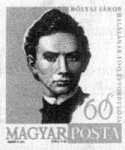 János Bolyai - (b. 15 Dec 1802 Kolozsvár, Hungary/Transylvania [now Cluj, Romania] d. 27 Jan 1860, Hungary/Transylvania [now Tirgu-Mures, Romania]) János Bolyai - (b. 15 Dec 1802 Kolozsvár, Hungary/Transylvania [now Cluj, Romania] d. 27 Jan 1860, Hungary/Transylvania [now Tirgu-Mures, Romania])
Mathematician - Discovered non-Euclidian hyperbolic geometry while at the University of Kolozsvár. Bolyai was educated by his father, famed matmematician Farkas (Wolfgang) Bolyai, in Marosvásárhely and by the time he was 13 had mastered calculus and other forms of analytical mechanics. Bolyai also became an accomplished violinist and he performed in Vienna. He received military training and studied at the Imperial Engineering Academy in Vienna from 1818 to 1822. Immediately after this he joined the army engineering corps in which he spent 11 years. He was the best swordsman and dancer in the Austrian Imperial Army. He neither smoked nor drank, not even coffee, and at the age of 23 he was reported to still retain the modesty of innocence. He was an accomplished linguist speaking nine foreign languages including Chinese and Tibetan. János Bólyai's absolute geometry laid the foundations of modern geometry by resolving the 2000 year old problem of geometry. It opened new horizons in mathematics,. physics, and even in philosophy since it refuted the Kantian concept of "a priori space." Bolyai was plagued with a fever which frequently disabled him and in 1833 he was pensioned off from his army career. Although he never published more than the 24 pages of the Appendix he left more than 20000 pages of manuscript of mathematical work when he died. These are now in the Bolyai-Teleki library in Marosvásárhely (Tirgu-Mures). "János Bólyai, more explicitly than Riemann, almost a century ahead of General Relativity, pointed at a possible connection between gravity and geometry, proving thereby his deep insight into the understanding of the laws of nature" - Zoltan Bay Trivia: - In the southern part of the far side of the moon is the János Bolyai Crater; a bit east of it is the Roland Eötvös Crater
- See the Columbia Encyclopedia
- See The Spirit of Hungary or Purchase this incredible book!
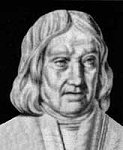 Farkas Bolyai - (b. 9
Feb 1775 Bolya [near Nagyszeben], Hungary/Transylvania [now Sibiu, Romania] d. 20 Nov 1856 in Marosvásárhely, HungaryTransylvania [now Tirgu Mures, Romania]) Farkas Bolyai - (b. 9
Feb 1775 Bolya [near Nagyszeben], Hungary/Transylvania [now Sibiu, Romania] d. 20 Nov 1856 in Marosvásárhely, HungaryTransylvania [now Tirgu Mures, Romania])
Mathematician From the Columbia Encyclopedia: Farks Bolyai was educated in Nagyszeben from 1781 to 1796 and studied in Germany during the next three years at Jena and Göttingen, where he began a lifelong friendship with "The Prince of Mathematics," Carl F. Gauss. From 1804 to 1853 he was professor of mathematics at Maros Vásárhely. His primary interest was in the Euclidean parallel postulate. His principal work, the Tentamen (1832-33), inspired by his mathematically gifted son János, is an attempt at a rigorous and systematic foundation of geometry (Vol. I) and of arithmetic, algebra, and analysis (Vol. II). - Read more at Farkas Bolyai or see the Columbia Encyclopedia
- See The Spirit of Hungary or Purchase this incredible book!
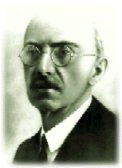 Kálmán Kandó - (b. 1869, d. 1931) Kálmán Kandó - (b. 1869, d. 1931)
Inventor/Engineer - Discovered triple phase high tension current for electric locomotion and industrial applications. He is the Father of Modern Electric Trains! He attended high school in Budapest, and obtained his diploma as a mechanical engineer at the Budapest Technical University. He worked in France as a junior engineer designing and developing Tesla's induction motor. András Mechwart (the Ganz factory's managing director at that time) called Kandó to return home in 1894. Shortly afterwards, Kandó designed the three-phase motor and generator series. Following these successful achievements at home he worked in Italy, later returning to Budapest to work at the Ganz factory where he became the managing director. One of the sensations of the summer season in 1898 was a small electric train carrying the guests of a French lakeside hotel at Evian Les Bains to and fro the close-by medicinal spring. The motor wagon was supplied by the Budapest-based Ganz Factory. The "S"-shaped track was merely 300 meters long, the train ran only at a speed of 10 km/hour, yet, its novel construction aroused great interest. It was designed by a 29-year-old engineer, Kálmán Kandó, who had been already working on a project of much greater size, the electrification of the Northern-Italian Valtellina Railway...
A total of 30 percent of this 106 km long line ran through tunnels and half of it ran along curves. For the first time in railway history, Kandó applied high-voltage, 15-period, 3-phase system for electric traction, a daring solution at that time. Kandó's brilliance in both mechanical and electric engineering allowed him to work out all the details of his concept alone. The Valtellina line was opened on September 4, 1902 and its success earned great international recognition for Kandó. At the end of World War I, Kandó pointed out that railway electrification is "only one chapter in the great problems of energy management and can be tackled successfully only within this context". His research focused on creating large energy systems, in which electric current generated for lighting and industrial use, were also used for electric haulage. He worked out a revolutionary system of phase-changing haulage, whereby locomotives were powered by the standard, 50-period, single-phase alternating current used in the national energy supply system. By integrating the electric power needs of the railways, the industry and the public, Kandó managed to find the ideal solution for energy rationalisation for any country. Kandó's invention of the phase-changing electric locomotive undoubtedly opened a new epoch in the history of railway development. - See Hungarians in the History of Transportation or - Hungarian Inventors at the Hungarian Patent Office
- See The Spirit of Hungary or Purchase this incredible book!
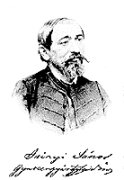 János Irinyi - (b. May 17, 1817, Nagyléta, Hungary - d. 1895) János Irinyi - (b. May 17, 1817, Nagyléta, Hungary - d. 1895)
Chemist - Invented safety matches!
János Irinyi was born in Nagyléta, attended middle school in Nagyvárad and later studied law in Debrecen. He acquired his chemical knowledge at the Vienna Polytechnikum. During one of his professor's experiments, he solved the puzzle of making silent matches. After long hours of experimentation he patented his invention of silent and non-explosive matches in 1836. In the heads of the matches he mixed phosphor with lead dioxide instead of calcium chlorate. Irinyi sold his invention to a manufacturer of matches and went for a study tour abroad. He became a student at the famous Agricultural College in Berlin. After returning home he founded the first factories for matches in Pest in different parts of the city. He wrote several articles on chemistry and published his textbook for schools entitled The Elements of Chemistry. Irinyi played an important part in the revolution of 1848 and 49. After assisting his brother with drafting the 12 points outlining the reasons for Hungary's desire to break with Austria, Louis Kossuth (the Father of Hungarian Democracy and leader of the revolution) assigned him to direct the manufacture of guns and gunpowder, and put him in charge of supervising the national factories. After the failed revolution he was sentenced to jail. When he won freedom he retired from political life and continued his scientific work exclusively. In the realm of common knowledge only his association with matches is remembered. Yet Irinyi was one of the first people to spread general knowledge about the new chemistry, and played a significant part in the development of the Hungarian technical language of chemistry. - See Hungarian Inventors at the Hungarian Patent Office or in Hungarian: http://www.kfki.hu/chemonet/hun/mvm/irinyi/irinyi.html
- See The Spirit of Hungary or Purchase this incredible book!
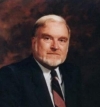 Mihály Csikszentmihályi (b. Hungary, d.) Mihály Csikszentmihályi (b. Hungary, d.)
Renowned Psychologist - Father of "Flow Theory," former Chair of University of Chicago's Department of Psychology, and Bestselling Author Professor Mihaly Csikszentmihalyi (pronounced "ME-high CHEEK-sent-me-high-ee"), of Transylvanian descent, seeks to answer what makes "creative" people creative. His primary interests are in the study of creativity, especially in art; socialization; the evolution of social and cultural systems; and the intrinsically rewarding behavior in work and play settings. The Hungarian-born polymath and currently the Davidson Professor of Management at the Claremont Graduate University, in Claremont, California has been thinking about the meaning of happiness since a child in wartime Europe. His research and theories in the psychology of optimal experience seek to find out how creativity has been a force in our lives and have revolutionized psychology, and have been adopted in practice by national leaders such as Bill Clinton and Tony Blair as well as top members of the global executive elite who run the world's major corporations. In the pages of Newsweek, President Clinton named him one of his favorite authors. Speaker of the House Newt Gingrich put his work on the reading list for a political planning committee. And corporations and cultural institutions - from Volvo in Sweden to the Chicago Park District to the political leadership of Austria - have seized upon his ideas and how to apply them because his findings have much to offer anyone interested in improving his or her understanding of how people can perform optimally in every area of life. In his bestselling book, "Flow: The Psychology of Optimal Experience," Professor Csikszentmihalyi interviewed 91 creative people like actor Ed Asner, scientist Jonas Salk, and Senator Eugene McCarthy, to find out what makes them special. He did exhaustive analysis of the data collected and found that certain traits are common to all creative people. He explored states of "optimal experience" when people report feelings of concentration and deep enjoyment and showed that what makes experience genuinely satisfying is a state of consciousness called "flow." Professor Csikszentmihalyi explores why creative people are often seen as arrogant (even though they are not) and reveals that the idea of the tortured genius is largely a myth. Csikszentmihalyi suggests methods for all of us to nurture these traits to explore and expand our creative potential. He argues that creativity needs to be cultivated not only in traditionally creative fields like sciences and arts, but also in business, government, and education. For the past twenty years he has been funded by the US Public Health Service and the Spencer Foundation for research and studies on topics related to "flow." His research has attracted much interest as can be seen in articles in Psychology Today, the New York Times and other newspapers. He is also a member of the National Academy of Education and National Academy of Sciences. He has been a Senior Fulbright Fellow and currently sits on several boards, including the Board of Advisors for the Encyclopedia Britannica. He has been on numerous TV networks and has been involved in various segments of "Nova." His other books include "Beyond Boredom and Anxiety," "The Evolving Self: A Psychology For The Third Millennium," "Creativity: Finding Flow,"and Good Business: Leadership, Flow and the Making of Meaning." He is also co-author of "The Creative Vision,""The Meaning of things" and "Being Adolescent." Trivia: - His book "Flow" was described on the 1993 NBC Super Bowl broadcast as the book that inspired Jimmy Johnson, then coach of the Dallas Cowboys.
- Read some his memorable quotes
- See his official Website
- Buy his books at Gurteen or see a larger selection at Amazon
Ottó Bláthy, Miksa Déri, Károly Zipernowsky
The "Great Triad" - The Three Electrical Engineers at the Legendary Ganz Factory: Fathers of Electricity Distribution and the Transformer It is an exceptional moment in the history of a nation and of science as well, when several of its masterminds have been able to work almost simultaneously and at the same place of work. Their names are mentioned together by historiography. The great triad of Otto Titusz Blathy, Miksa Deri, and Karoly Zipernowsky was connected by the transformer, their revolutionary invention presented in 1885. Besides the transformer, however, other joint works were produced during their years of creativity. In 1882 the illumination of the National Theatre was installed to the plans of Károly Zipernowsky. At the time, this was only the third theatre in the world to be illuminated by electricity (after the Savoy in London and the theatre in Brünn [Brno]). However, all had to use a local generator, as there was no method available for transporting electric power. This seriously handicapped the more widespread use of electric power, and experiments were conducted in many places to solve this problem. The first practical solution was found in Budapest, at the Ganz factory. In 1885, after one year of research and development, the Triad invented a device of two coils with a closed iron core, with variable ratio induction, which they called a transformer, the name used ever since. This device was the basis of alternative current (AC) power distribution networks. Such a network was installed at the National General Exhibition in Budapest (May to November 1885) where the system worked faultlessly without interruption. During the following decades, the Ganz factory manufactured and installed several hundred power distribution systems using their own components. In 1886 they installed the Rome-Cerchi steam power plant, the first power plant built to supply a large city with electricity. This was the very first power plant which used, on the proposal of Bláthy, AC generators to supply a common network in parallel connection. The Ganz factory produced electrical equipment for the power network of the city of Rome over several decades. Individual portraits:
 1) Ottó Bláthy - (b. 1860, Tata, Hungary - 1939) 1) Ottó Bláthy - (b. 1860, Tata, Hungary - 1939)
Father of the electric transformer, the tension regulator, the watt meter, the alternating current motor, the turbogenerator and high efficiency turbogenerator. Even as a young pupil, Blathy excelled by his affinity to Mathematics, and his teacher often called him in front of his senior school-mates to solve the problems that they had not been able to cope with. From this small town of Tata, he went to the technical university of Vienna, where he received his engineer's degree in 1882. Ottó Titusz Bláthy was not satisfied with theory only. He discovered the practical application of the connection between the magnetic field and the excitation creating it. This led to an improved design of DC engines. From the experiments he developed a science of then unforeseeable practical benefits. In 1884, he designed an automatic mercury voltage regulator for direct-current dynamos as his first patent. In the years to come, the generators of several current-generating plants in Italy were operated by this regulator. From 1884 on, on the basis of another patent of his, high-precision watt meters were produced. These were the first instruments with which the power of alternating current could be measured for any phase shift between voltage and current. Bláthy went to work to the Ganz Works in the summer of 1883, where experiments in connection with creating a transformer had already begun. He immediately joined the work, and as early as 1885, the alternating-current transformer, the revolutionary invention of the great triad was presented; power transmission even to great distances could be solved with it. The new system was presented at the National Exhibition in Budapest in 1885. The entire area of the exhibition was illuminated by alternating current, distributed at 1,350 Volt primary voltage, of a frequency of 70 Hz, utilizing 1,067 incandescent lamps and 75 small shell-type transformers. It was an immense success. Bláthy soon departed from the lights of Pest, leaving for America, where he also visited the Edison Works. It was there that he observed that the parameters of the exciting coils of the machines to be produced were established on the basis of empirically set charts. Bláthy proved that these data can be arrived at by way of rigorous calculations as well, thus winning the admiration of the engineers at the factory. He did not stay in America for a long time. Work in the Ganz Works was awaiting him. - Read more about Otto Blathy 2) Miksa Déri - (b. 1854, Bács, Hungary - 1938)
Developed A/C electric generator
|
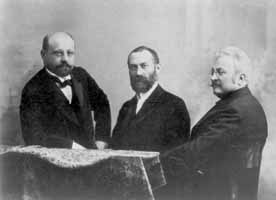
| |
Deri, Blathy, and
Zipernowsky |
Born in Bács, Miksa Deri obtained his diploma in hydraulic engineering in 1877 at the Technical University of Vienna. Between 1878 and 1882 he was engaged in designing of the Duna and Tisza river control systems. At the same time he studied electrotechnics. In 1882 he started working at the Ganz factory as an engineer. Later on he became the factory's director, at a time when a remarkably talented professional team worked in the factory. Along with fellow Hungarian, Zipernowsky, they developed a self-excited AC (alternating current) generator during that year, which they began manufacturing in 1883. From 1833 Miksa Déri worked in Vienna as the Austrian representative of the Ganz factory electrical department. In 1885 jointly with Ottó Bláthy and Károly Zipernowsky, they created the transformer. Déri performed the brunt of the experimental work. From 1889 he organized and equipped the electric power station in Vienna. Between 1898 and 1902 he worked on his compensated DC machine. Two years later he designed the repulsion motor which was later named after him. Déri's repulsion motor filled up an important gap in equipping lifts, namely, no lift motor had worked safely until then. These brush-type motors were mass-produced and used all over the world.
 3) Károly Zipernowsky - (b. 1853, d. 1942) 3) Károly Zipernowsky - (b. 1853, d. 1942)
A/C electronics pioneer! Founder of heavy-current electrical engineering Born in Vienna, he completed his studies in Budapest. During his Technical University years he gave many lectures on the subject of electronics. In 1878 András Mechwart, the Ganz factory's managing director entrusted him with organizing their electricity department. Since Ganz was the first factory in Hungary engaged in electricity, it thus became his task to develop the power industry in Hungary. Under Zipernowsky's leadership the factory soon became the pioneer in AC electronics. In 1883 the National Theatre of Budapest was fitted with lights by the Ganz company: this was the first alternating current, incandescent lighting system in Hungary (the third theatre in the world). It is worth mentioning that one of their AC generators, the "giant steam lighting machine", illuminated the Keleti Railway Station for thirty years. In the 1880s scientists were often engaged in working on the distribution of electric light. Edison had solved the problem of carrying light economically to short distances with DC (direct current). Historical credit is due to Zipernowsky and his colleagues for developing the economical transmission and distribution of light to long distances. In 1889 he developed with Miksa Déri and Ottó Bláthy the transformer and the AC (alternate current ) energy distribution system based on transformers connected in parallel shunt. It should also be mentioned that AC or DC was not a settled question from the start. Edison, who backed DC, was proved wrong, the young Hungarian engineers were right. The state of the art electric equipment they produced was admired by the trade all over the world. (Western Electrician, Chicago, May 25th, 1889.) In 1893 Zipernowsky acquired the position of lecturer in the department of power electronics at the Technical University, and became a corresponding member of the Hungarian Academy of Sciences. From 1905 he was active as the president of the Hungarian Electronic Association. - Read more about Karoly Zipernowsky.
- See "Innovators and Innovations"
 János Kabay - János Kabay -
First to isolate morphine directly from the plant. His patent, of worldwide significance, still serves up to the present day as the basis for the industrial process used throughout the world. By this process the opiate alkaloids are extracted from the dry capsules of the mature poppy (Papaver somniferum) plant. Kabay's breakthrough in 1928 produced a commercially feasible morphine extraction process. During the Second World War, poppy straw processing began under German control as a source of opium during the Allied blockade. Since then, refinements to extraction techniques, and agricultural development have greatly increased yields, so that today more than 50 per cent of the world's legal annual morphine demand of about 230 tons is derived from this source which, in some countries such as Australia, is a highly mechaniezd agricultural procedure. - Read, "Opium: A History"
 Ignác Fülöp Semmelweis (b. 1818, Buda, d. 1865, Vienna) Ignác Fülöp Semmelweis (b. 1818, Buda, d. 1865, Vienna)
Physician - "The Mothers' Savior" - Discovered Cause of Puerperal Fever Made the first effective attack on bacteria, and discovered the cause of puerperal fever, which was killing thousands of mothers. Semmelweis insisted that doctors disenfect their hands before childbirth. Though the death rate fell from 12% to 1.5%, the Austrian doctors were offended by his suggestions (and the fact that he was a Hungarian in Vienna during the anti-Hapsburg revolution) and sent him back to Budapest. Ironically, he too, fell to puerperal fever due to an accidental infection. Sir William Sinclair writes, "It is the doctrine of Semmelweis which lies at the foundation of all our practical work today."
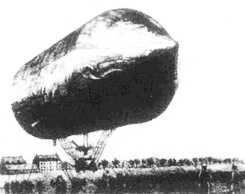 Dávid Schwartz (b. 1845, d. 1897) Dávid Schwartz (b. 1845, d. 1897)
Inventor, Wood Trader? - Father of the Dirigible Air Ship or Zeppelin
The Hungarian inventor of the dirigible airship was not an engineer, not even a technician. He was a wood trader. Like many technically interested people in those years, he became increasingly fascinated by aviation, the great human adventure of the late 19th century. Schwartz studied the airship and came up with a novel idea. With the very thin aluminum he used for insulating the balloon, the aluminum skeleton, and the propellers at the sides of the basket, he set the course for the airship's future development. He submitted his design to the Austro-Hungarian Defense Ministry in Vienna, which classified the proposal as "inextricable" and discarded the idea. Schwartz invested all his money in further tests. The Prussians recognized the significance of the invention (it used aluminum, the exciting new material) and financed the making of the new airship. The trial flight in October, 1895, did not succeed, because of the poor quality gas used for the filling of the balloon. Schwartz, who by now had become obsessed with his idea, began to look for the proper gas. The frustration and the ceaseless pursuit of additional funding, undermined Schwartz's health. He died on January 11, 1897. The Prussian Defense Ministry continued tests with his airship. The first launch of the world's thus far largest capacity, 47.5 meter long, cigar-shaped airship weighting 3500 kg took place on November 3, 1897. The widow of Dávid Schwartz who lived in great poverty after his death sold all the patent rights to Graf Zeppelin for 15 thousand Deutschmarks....and two years later the first "Zeppelin" airship rose from Lake Constance... and 25 years later Captain Eckener crossed the Atlantic in 80 hours... Zeppelin had gained a brilliant victory, but the name of the man who conceived it technically has sunk into oblivion. See Hungarians in the History of Transportation
 Bishop Faustus Verancsics (b. Dalmatia 1551 - 1617), Bishop Faustus Verancsics (b. Dalmatia 1551 - 1617),
Invented the air turbine, one of the most famous engineers in the Middle Ages He was educated in Pozsony, Hungary (now Bratislava after Czech annexation) in the home of his uncle, Antal Verancsics, the Archbishop of Esztergom. After studying at the university in Padua, he returned to Pozsony to devote himself to the study of scientific problems. He was given the captainship of the castle of Veszprém, in western Hungary, before becoming the Emperor Rudolf's secretary for Hungarian affairs. Later he became a priest and ultimately the Bishop of Csanád. In the last one and a half decades of his life he went to Italy, where he became a monk. He lived in Rome and Venice and his writings were published there. He compiled a five-language dictionary-Latin, Italian, German, Croatian, Hungarian-which was published in 1595. All his life he pursued solutions for technical problems, thus developing several new ideas and inventions. In 1616 he published Machinć Novć, which was a summary of his ideas and a significant work in the history of science. The book describes more than sixty inventions, forty-nine of them with detailed illustrations. His inventions cover a wide range: grinders, windmills, tide-mill, compacting machine, twelve variations of bridge structures, the suspension-bridge, the parachute (closer to the present paraglider), a dredger, a rope-weaving machine, a steel spring and friction brake for coaches. - See more in Hungarian at Technical History
 Donát Bánki / János Csonka
- (1859 - 1922) (1852-1939) Donát Bánki / János Csonka
- (1859 - 1922) (1852-1939)
 Engineers: Invented the carburetor and dual evaporation Engineers: Invented the carburetor and dual evaporation Until 1893, there had been many problems with the ignition of petrol engines due to uneven mixing of gases: the device, used to vaporize gasoline and mix it with the air, could not produce the precise mixing proportions. The carburetor (on the right) invented by Banki and Csonka immediately eliminated these problems. As so many times in technical history, the invention was conceived through a freak of fortune.
 One evening, Banki walked home from the Technical University when he saw a flower-girl sprinkling water on her flowers with a mouth-blown spray. This sight led him to one of the most revolutionary ideas of engineering. Banki and Csonka suggested that the fuel should be atomized into small particles and mixed with air in the right proportion before feeding it into the combustion engine. In their patent description submitted on February 11, 1893, they wrote: "...in our engine no petrol pump is needed for fuel feeding, as the petrol necessary for filling each cylinder will be carried in by the air sucked into the engine..." This was the first carburetor in the world and ever since billions of engines, cars, power-boats, motor bicycles and aircraft over the world have used carburetors designed according to Banki's and Csonka's theory. Unfortunately, the credit for the invention of the carburetor is usually given to the German Maybach, although his patent was submitted half a year later. In 1898 Banki and Csonka split. Bánki focused his research on improving his other invention, water-injection engines. In 1898 he invented the high compression Bánki-engine with a dual-carburettor (for evaporating fuel and water). This engine won an award at the 1900 World Exhibition in Paris. Dual evaporation has been in use ever since. One evening, Banki walked home from the Technical University when he saw a flower-girl sprinkling water on her flowers with a mouth-blown spray. This sight led him to one of the most revolutionary ideas of engineering. Banki and Csonka suggested that the fuel should be atomized into small particles and mixed with air in the right proportion before feeding it into the combustion engine. In their patent description submitted on February 11, 1893, they wrote: "...in our engine no petrol pump is needed for fuel feeding, as the petrol necessary for filling each cylinder will be carried in by the air sucked into the engine..." This was the first carburetor in the world and ever since billions of engines, cars, power-boats, motor bicycles and aircraft over the world have used carburetors designed according to Banki's and Csonka's theory. Unfortunately, the credit for the invention of the carburetor is usually given to the German Maybach, although his patent was submitted half a year later. In 1898 Banki and Csonka split. Bánki focused his research on improving his other invention, water-injection engines. In 1898 he invented the high compression Bánki-engine with a dual-carburettor (for evaporating fuel and water). This engine won an award at the 1900 World Exhibition in Paris. Dual evaporation has been in use ever since.
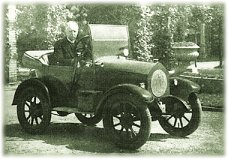
Csonka (seen in his hand-made car on the right from 1909) concentrated on automobiles. In 1904, the Hungarian Post Office announced an international tender for the purchase of 8 mail vans. The tender was won by Csonka's original, four-cylinder car, which started its 8-day, 2000-kilometre trial run on May 31, 1905. This date is considered the birth of Hungarian automobile manufacturing. - See Hungarians in the History of Transportation or Hungarian Inventors at the Hungarian Patent Office
- See The Spirit of Hungary or Purchase this incredible
book!
 Jenö Fejes (1877-1952) Jenö Fejes (1877-1952)
Engineer, Inventor - first in the world who submitted patents for manufacturing automobile parts by cold-forming, pressing, torch or spot-welding.
Many Hungarian engineers and researchers played a significant role in the development of automobiles. One of them, Jeno Fejes, an unfairly forgotten designer, was the first in the world who submitted patents for manufacturing automobile parts by cold-forming, pressing, torch- or spot-welding. Soon after graduation, from 1902, Fejes was employed in the Westinghouse factory in France. The factory's car, designed by Fejes, won first prize at the Coup de la Presse race in 1907. From 1911 Fejes worked as constructor in the Mátyásföld plant of the Hungarian General Engineering Co. He recognized that certain problems with the engines, stemming from casting difficulties or overweight, could be avoided if engines were constructed not using the cumbersome and unreliable casting techniques. The fast development of welding and pressing techniques helped to solve this problem. His first patent, "Extrusion of cylinder heads of combustion engines", was submitted on September 20, 1921. A year later this was followed by another patent application, "Vehicle chassis for automobiles and its manufacturing process." Fejes replaced all cast and heavy pressed parts with cold-formed parts made of iron and steel plates. His other patents covered the manufacturing of the engine-house, the steering gear, the rear axle and the motor block. Cold forming allowed the use of steel plates of much smaller thickness than that of casts and thus the dead-weight of vehicles designed by Fejes was 30 to 35 percent lighter than cars manufactured using traditional methods. Another advantage of the plated engine was that on impacts, it dented and did not rupture as easily as cast engines. In 1922 Fejes established a company in Hungary to implement his patents and, in 1927, he set up "The Fejes Patents Syndicate Ltd." in England. After a successful pilot run, another company, Ascot Motor and Manufacturing Co. Ltd. was created with a founding capital of 400,000 pounds sterling. However, Austin, then a leader in the UK car market, was afraid of Ascot spoiling the market with its low-cost cars and used its influence as a share-holder in the company to thwart the launching of the series production. Fejes' inventions were ahead of their time: They were put into practice only from the 1970's. - See Hungarians in the History of Transportation or
- Hungarian Inventors
 Baron Loránd Eötvös - (b. 7/1848 - 4/1919) Baron Loránd Eötvös - (b. 7/1848 - 4/1919)
Mathematician - Developed the method and tool to measure gravity: His inventions made it possible to explore for natural resources like oil, coal, and different ores Scientific literature and usage bears ample evidence of his inventions: the Eötvös Law of Capillarity; the Eötvös Unit of Gravitation (roughly one-billionth of a gram); the Eötvös Gravitational Torsion Balance of almost incredible sensitivity; the Eötvös Effect: and inventions of instruments for measuring terrestrial magnetism for decades to come. The torsion balance made it possible to explore for natural resources like oil, coal, and different ores. Eötvös also recognized the correlation between surface tension and molecular weights of liquids measured at various temperatures. This led to the Law of Eötvös which was declared by Einstein to be one of the pillars of his theory of relativity and was applied in his "theory of equivalence." See more at St. Andrew's Archive: Baron Loránd Eötvös
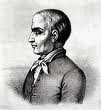 Sándor Kőrösi Csoma - (b. 4/4/1784, Kőrös, Transylvania, Hungary (annexed by Rumania)- d. 4/11/1842, Darjeeling) Sándor Kőrösi Csoma - (b. 4/4/1784, Kőrös, Transylvania, Hungary (annexed by Rumania)- d. 4/11/1842, Darjeeling)
Explorer and Scholar "Father of Tibetan Studies and Buddhist Culture" Walked from Hungary to Tibet and presented the world with the first Tibetan dictionary and grammar and became a Buddhist Saint! Awareness of the Hungarians' oriental origin never fell into oblivion, and questions regarding the history of the people and the language focused the attention of scholars toward Asia as a matter of course. First to set off toward the Orient was the legendary and world-famous Hungarian orientalist Alexander Csoma Korosi also known as Alexander Csoma de Koros. Born of a poor Szekler family, he began his studies as a servant and student at the college of Nagyenyed in Transylvania. From 1815, he pursued oriental linguistic studies at the University of Göttingen in Germany on an English scholarship. Here the determination matured in him to leave for Asia on foot and explore the ancient homeland of the Hungarians. He mastered the Turkish, Arabic, Persian and Bengali languages. During his travels starting in 1819 he reached India through Iran and Afghanistan. In Western Tibet, encouraged by the English traveller and scholar W. Moorcroft, his attention turned toward researching the Tibetan language. In his first three visits to Tibet he spent more than five years in various monasteries conducting a monk-like existence. He was the one to discover that the holy scriptures of Buddhism had not been irretrievably lost, as had been thought earlier on, but were retained in Tibetan translation. He was the first to outline in 1836-39 the content of the 325-volume Tibetan Buddhist canon, Kandjur ('The translation of Buddha's tenets') and Tandjur ('Translations of Explanations') and the life of Buddha who had founded a religion. His articles promoted research into Buddhism, and Schopenhauer learned from his studies about Buddhism, which were to exert a decisive influence on him. After five years, he emerged with the world's first Tibetan dictionary (containing 40,000 words) and grammar book which were published in an English edition in 1843. Without any bias we can state that Alexander Csoma Korösi is a great founding father of not only Tibetan studies but that of Buddhist culture as well. Tragically, on his fourth journey to Tibet, having at last obtained some information about the Yougar people (a race possibly related to the Magyars), he was fatally struck with malaria and died in Darjeeling without finishing his long search. Korosi-Csoma is buried in Darjeeling, his grave marked by a monument erected jointly in 1910 by the Hungarian Academy of Sciences, the Transylvanian village of Csomakőrös and the Asiatic Society of Bengal. There can't be many Europeans whom Buddhists revere as a saint but the Hungarian Sándor Csoma Kőrösi is one. His grave, which lies at the foot of the Himalayas, is a place of pilgrimage. When the Dalai Lama visited Hungary he also spoke of Korosi as being a saint, and if anybody is qualified to make a pronouncement on this subject it is his Holiness. Today there stands a statue of Csoma de Koros at the Buddhist Unversity of Japan, where he sits in the lotus position, befitting the bodhisattva he had been declared in 1933. Trivia: -
Walked from Hungary to Tibet and learned 17 languages along the way -
Also known as Skander Beg the Armenian, or Phyi-glin-gi-grwa-pa (Tibetan for 'foreign pupil') -
Ushered in the "New Age" by making Buddhism and Tibetan culture accessible to the west -
His tomb has been declared a protected monument by the Government of India and is one of the landmarks of Darjeeling - See The Spirit of Hungary or Purchase this incredible book!
- See the The birth and achievements of Hungarian oriental studies
- Read a great summary and buy the amazing book, The Hungarian Who Walked to Heaven, by Edward Fox
- See Profiles of Tibetan Buddhists
 József László Bíró - (b. 1899, d. 1985) József László Bíró - (b. 1899, d. 1985)
Inventor - Developed the Ballpoint Pen AND the Automatic Gearbox for Automobiles. The Ball Point Pen:
A journalist, magazine publisher, sculptor, and painter in Budapest, Laszlo Biro noticed, during a visit to a printer's, how quickly the printer's ink dried. It occurred to him that this fast-drying ink would work well in a fountain pen. This dense ink, however, would not flow through a pen. Therefore, Biro decided to replace the metal writing nib of his pen with a slim ball bearing. As the pen moved across the paper, the ball turned and suctioned ink from the reservoir, which then transferred it to the paper. The "Biro" was born. He first patented the pen in 1938. In 1940 he and his brother ran away from Hungary to Argentina where, in 1943, he patented his pen again. A clerk of the British government, Henry Martin, who was, by chance, at that time in Argentina, was interested in the fact that Biro's pen wrote at any altitude above sea level, and therefore because it was not affected by air pressure or other atmospheric conditions. it immediately occurred to him to make it available to navigators in airplanes. The British government bought the patent and in 1944 a pen under the brand name Biro was produced for the Royal Air Force. Their successful performance for the Air Force brought the Biro pens into the limelight. Biro had neglected to get a U.S. patent for his pen and so even with the ending of World War II, another battle was just beginning. The U.S. Department of State sent specifications to several American pen manufacturers asking them to develop a similar pen. In an attempt to corner the market, the Eberhard Faber Company paid the Biro brothers $500,000 for the rights to manufacture their ballpoint pen in the United States. Eberhard Faber later sold its rights to the Eversharp Company. The first great commercial success for the ballpoint pen came on an October morning in 1945 when a Crowd of over 5,000 people jammed the entrance of New York's Gimbel's Department Store. The day before, Gimbel's had taken out a full-page ad in the New York Times promoting the first sale of ballpoints in the United States. The ad described the new pen as a "fantastic... miraculous fountain pen ... guaranteed to write for two years without refilling!" On that first day of sales, Gimbel's sold out its entire stock of 10,000 pens-at $12.50 each! The Automatic:
He bought a red Bugatti car one day, but found the clutch mechanism too clumsy and began to muse about an automatic solution. After one year of experiments, he made and patented his "automatic gear-box". For its mass production Bíró did not have enough capital and decided to sell the patent. The German subsidiary of General Motors requested him to introduce the patent in Berlin. To prove his invention's reliability, Bíró installed it on his own 350-CC combination motor bicycle, had its gear box sealed by the Automobile Club and with a passenger in the side car drove 1000 kilometres to Berlin, over hill and dale, without any fault. In Berlin he made four successful test drive. GM's draft contract offered him half percent of the price of each unit sold and a monthly USD 200 advance for five years. This latter secured him an easy life for a while, but the license fee was never paid, as, for commercial reasons, the American company suppressed the patent and sank it to the bottom of a filing cabinet. Trivia:
In Argentina, inventors' day is celebrated on Biro's birthday - See Hungarians in the History of Transportation or
- A Brief History of Writing Instruments or
- Read more about the Ball Point Pen
 Paul Selényi (b. 11/17/1884, Dunaadony - d. 3/21/1954, Budapest) Paul Selényi (b. 11/17/1884, Dunaadony - d. 3/21/1954, Budapest)
Physicist and Father of Electrostatics / Photoconductivity Pioneer - first to record images with an electrostatic marking process: the foundation of Carlson's Xerography! Pál Selényi studied physics and mathematics at the Budapest University. After finishing his studies he started to work for the newly established Applied Physics Department of the University. In his early works he was engaged in studying the nature of light. Selényi was a physicist with great technological interest. He worked for various companies, e.g. for the development laboratory of the Tungsram Ltd. He published more than hundred articles in the field of optics, vacuum technology, photometry and electrography, studied and developed photocells, seleniumdiodes and photoelements. His pioneering work in electrostatic picture recording formed the basis of xerography. In fact Selényi published and patented several fundamental idea of electrography and produced better quality electrografic copies well before C. F. Carlson to whom the invention of electric recording is ascribed to. Selenyi was the first to record images with an electrostatic marking process in which a modulated ion source was scanned over an insulating layer to form an electrostatic image that was subsequently developed with powder. Selenyi coined the term "electrography" for his electrostatic imaging processed he invented in the 1920's. Carlson's invention was heavily influenced by the earlier work of Paul Selenyi. Carlson's insight was to use a photoconductive material to produce an electrostatic image that is then developed with charged, pigmented powder. Carlson built a prototype of a copying machine, but was unsuccessful in attracting the interest of large corporations. In 1944, Battelle Memorial Institute in Columbus, Ohio began work on the process where key advances were made in materials and processes. This led to the introduction of the highly successful Xerox 914 plain paper copier in 1959. Zworykin, television pioneer, wrote: "I recollect with great pleasure my visit during the next few days to the Tungsram Laboratories. It was surprising to me to find in a country as small as Hungary such a well-equipped laboratory and so much advanced work in electronics. One of the laboratories which impressed me particularly was that of Dr. Selenyi, who showed me a method of storing the image on used movie film by electrostatic charging with an electron beam transmitted by a thin-glass window on a cathode-ray tube. He was hoping to use this method for a large-screen television projection picture. As far as I know, he was not able to translate this idea into practice. However, the idea itself survived and many years later was used in modern copying machines." (p. 105 from Chapter 8 - Pre-War World-Wide Television Effort, Zworykin's European Travels 1935-1939) - Read more about his work at Optics by Hungarians
- Read about Electrostatics
 Egon Orowan (Orován) (b.
8/2/1901, Budapest, d. 8/3/1989, Cambridge, MA) Egon Orowan (Orován) (b.
8/2/1901, Budapest, d. 8/3/1989, Cambridge, MA)
Applied Physicist Applied physics reached world standards in northern Budapest, where the Tungsram Company was created (1896). The name of this light bulb factory originates from tungsten (wolfram), the beat resistant metal which was patented by Sándor Just and Ferenc Hanaman (1903), as the glowing fiber in light bulbs, instead of Edison's fragile carbon fibers. Tungsten (and Tungsram) made electric incandescent lamps long-lasting, so that the light bulb could become an everyday item. With Michael Polányi he was responsible for the introduction of the crystal dislocation into physics as the essential mediator of plastic deformation. The Tungsram employees Dennis Gabor, Egon Orowan, and Michael Polányi later became fellows of the Royal Society. Though he occasionally spoke at meetings concerned with science and technology policy, and wrote letters to the press on a number of topics, he was an essentially private person and left no biographical notes. While working on plasticity and fractures in solids, Orowan studied high resolution photographs brought back by the Apollo missions and proved that the craters on the Moon are not products of lunar volcanism but had been created by impacts of meteors from outside. M.I.T. has an award named The Egon Orowan Award for Outstanding Teaching. - Read a detailed biography and obituary at the National Academy Press or
- In Hungarian with a forward by Theodore Karman, father of US Aerospace or
- Read about him and his place among the great Hungarian Physicists
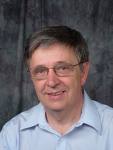 Laszlo Lovasz (b. 3/9/1948,
Budapest) Laszlo Lovasz (b. 3/9/1948,
Budapest)
Renowned Yale University Senior Faculty Mathematician, Microsoft Senior Researcher, Computer Scientist: 1999 Wolf Prize Winner Lászlo Lovász is a renowned leader in the field of discrete mathematics, an area quickly becoming one of the most important areas of mathematical research, with applications to cryptography, linear programming, coding theory and the theory of computing. Dr. Lovász received his Ph.D. from the prestigious Eötvös Loránd University in Budapest in 1970. Within a 5 years, he held the Chair of Geometry at the University of Szeged from 1975-1982. In 1983 he was back to his alma mater, this time as Chair of Computer Science at the Eotvos Lorand University, a post he held for 10 years until 1993 when he joined Yale faculty. His awards include the George Polya Prize of the Society for Industrial and Applied Mathematics (1979), the Ray D. Fulkerson Prize of the American Mathematical Society and the Mathematical Programming Society (1982) and the Brouwer Medal of the Dutch Mathematical Society (1993). He is a recipient of the 1999 Wolf Prize and the Godel Prize for the top paper in Computer Science. He is editor-in-chief of Combinatorica and editor of 12 other Journals. He has written 4 research monographs and 3 textbooks, and about 200 research papers. Some of his major works include: Combinatorial Problems and Exercises (1979), Matching Theory (M. D. Plummerrel, 1986), An Algorithmic Theory of Numbers, Graphs and Convexity (1987), Geometric Algorithms and Combinatorial Optimization (M. Grötschellel, A. Schvijverrel, 1988). He is a member of the Hungarian Academy of Sciences and three other Academies. He is also a Senior Researcher in the Theory Group at Microsoft Corporation. He is married with 4 children. Trivia: - Buy his books for a little "light" reading on Amazon
- Read some of his papers and download presentations on his personal Microsoft site
- Read about his Wolf Prize acceptance speech (in Hungarian)
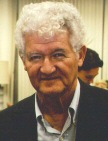 Peter Lax (b. 1926)
Peter Lax (b. 1926)
Renowned and Prolific Applied Mathematician and "one of the greatest figures in pure and applied mathematics of our times." 1987 Wolf Prize Winner Peter Lax is one of the greatest figures in pure and applied mathematics of our times. His work has been seminal and extraordinarily influential in almost all areas of mathematics and its applications where differential equations are involved, such as integrable systems, fluid dynamics and shock waves, solitonic physics, hyperbolic conservation laws, and so on. His contributions to mathematical and scientific computing are very significant. In 1970, Professor Lax risked life and limb to help prevent a bomb from destroying the NYU computer center. In August 2000, he will be one of about 30 plenary speakers at the AMS meeting in Los Angeles, Mathematical Challenges of the 21st Century. Professor Lax's work has been recognized by many honors and awards. He is a member of the National Academy of Sciences, USA. He was awarded the National Medal of Science in 1986, shared the Wolf Prize in 1987, the Chauvenet Prize for Mathematics, and shared the American Mathematical Society's Steele Prize in 1992. He is a past president of the American Mathematical Society, and a former Director of the Courant Institute, and past member of the National Science Board. He worked on the Manhattan Project with many of his fellow Hungarians, is a member of the Los Alamos Lab, and chaired the committee convened by the National Science Board to study Large Scale Computing in Science & Mathematics, a pioneering effort (well-known as the Lax Report). Professor Lax continues to be a leading and innovative force in mathematics and a tireless reformer of mathematics education. He is Professor Emeritus of Mathematics at New York University's Courant Institute. - Buy his books at Barnes and Noble
 Csaba Horváth (b. Szolnok, Hungary, d. 4/13/2004, New Haven, Connecticut) Csaba Horváth (b. Szolnok, Hungary, d. 4/13/2004, New Haven, Connecticut)
Renowned Professor of Chemical Engineering at Yale. Father of high-pressure liquid chromatography (HPLC) The American Chemical Society lists Prof. Csaba Horváth among greats like Crick and Watson, Linus Pauling, Pierre and Marie Curie, and Ernest Rutherford, individuals who have contributed most to the development of chemistry in the 20th century. Csaba Horváth, along with J. Calvin Giddings and J.F.K. Huber, had come up with the concept of the first HPLC instruments. In the mid-1960s, Horváth became the first scientist to design, construct, and demonstrate molecular separations using high-pressure liquid chromatography (HPLC), which has become a multi-billion-dollar business. The technique made possible quantitative analysis of complex biological mixtures and allowed advances in the areas of biomedicine, pharmacology, and biotechnology. Born in Szolnok, Hungary, Horváth graduated with a chemical engineering degree from the Technical University in Budapest in 1952. Because of Soviet repression, he immigrated to Germany in 1956 and joined Farbwerke Hoechst AG in Frankfurt am Main, where he performed research and development work on the surface chemistry of organic dyes. In 1961, Horváth left industry to attend Johann Wolfgang Goethe University, where he earned a Ph.D. in physical chemistry (magna cum laude) in 1963. In February 2004, Prof. Csaba Horváth was elected to the National Academy of Engineering "For pioneering the concept and the reduction to practice of high-pressure liquid chromatography (HPLC) and for leadership in the development of bioanalytical techniques." - See his site at Yale University
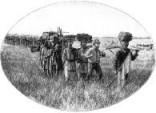 Count Samuel Teleki - (1854 - 1916) Count Samuel Teleki - (1854 - 1916)
Explorer! Led the famous East-Africa Expedition In 1886, the Hungarian count Samuel Teleki von Szék, "a jovial Hungarian aristocrat of immense wealth," accepted a suggestion from his friend and benefactor, prince Rudolf, son of the Austro-Hungarian emperor Franz-Josef I, to turn the safari he was planning into a journey of exploration of the territories north of Lake Baringo, beyond where Thomson had set foot. And so he did. Accompanied by lieutenant Ludwig von Höhnel (1856-1942), Teleki set on his way, being the first to climb Mount Kenya to later head on northwards and discover in 1888 the last of the Great Lakes, which he named after his friend the prince, and which we know today by the name of the tribe that inhabits its shores, Turkana. Teleki's and von Höhnel's journey also unveiled a smaller lake, Stefanie, south of Ethiopia, re-named later as Chew Bahir.
 Lake Turkana, a 2,500 square mile stretch of water, is alkaline, barely drinkable, and capricious. Sometimes it is calm and unruffled, often it is turbulent with an impression of malevolence, from a distance however it always stretches away peacefully and it's shimmering surface sometimes takes on the colour of Jade, and thus was aptly named the Jade Sea by Count Teleki in 1888. Strong winds blow constantly, temperatures soar well above 100F, and movements in the earth's surface are continually throwing up exposed sedimentary layers, many of which have preserved pre-historic fossils in a remarkably good state. Lake Turkana, a 2,500 square mile stretch of water, is alkaline, barely drinkable, and capricious. Sometimes it is calm and unruffled, often it is turbulent with an impression of malevolence, from a distance however it always stretches away peacefully and it's shimmering surface sometimes takes on the colour of Jade, and thus was aptly named the Jade Sea by Count Teleki in 1888. Strong winds blow constantly, temperatures soar well above 100F, and movements in the earth's surface are continually throwing up exposed sedimentary layers, many of which have preserved pre-historic fossils in a remarkably good state.
"The scenery became more and more dreary as we advanced. The barren ground was strewn with gleaming, chiefly red and green volcanic debris, pumice stone, huge blocks of blistered lava and here and there pieces of wood." Samuel Teleki, 1888 Count Teleki's father, also Samuel (b. Gernyeszeg, 1739, d. Vienna, 1822), was Lord Chancellor of Transylvania at the end of 18th century. He founded the Teleki library in Marosvásárhely, (renamed Tirgu Mures after Rumanian annexation in 1920) which holds more than 200,000 priceless volumes 40,000 of which from his personal collection. This "Bibliotheca Telekiana,"one of the first Hungarian public libraries, opened in 1802. Trivia: - The giant Lobelia plants found in the Afro-alpine belt of Mt Kenya are named Lobelia Telekii, after Count Samuel Teleki, the first white man to reach the alpine zone.
- Read more about the exploration of Kenya (1883-1892)
- Read about his expedition in Hungarian
|